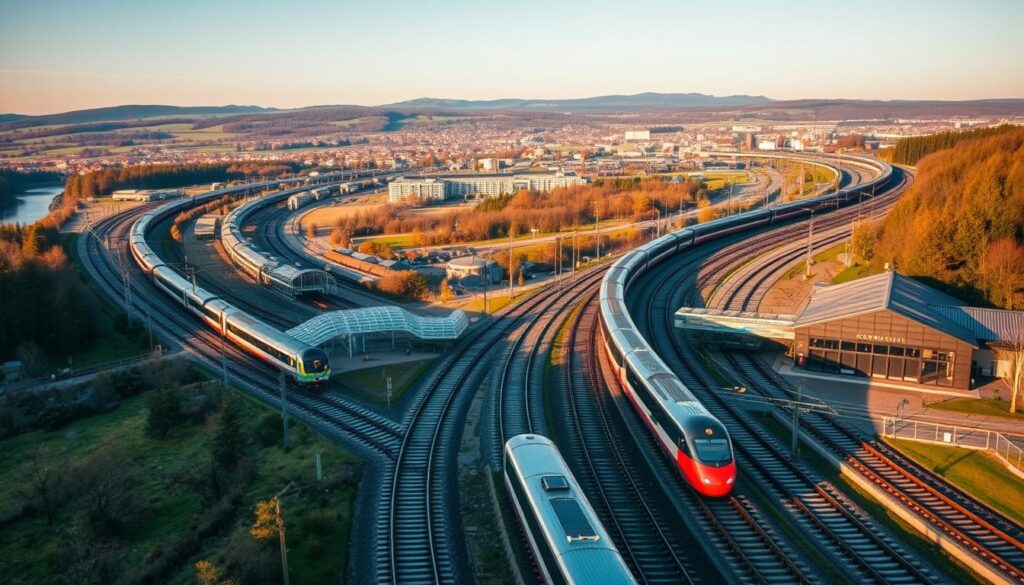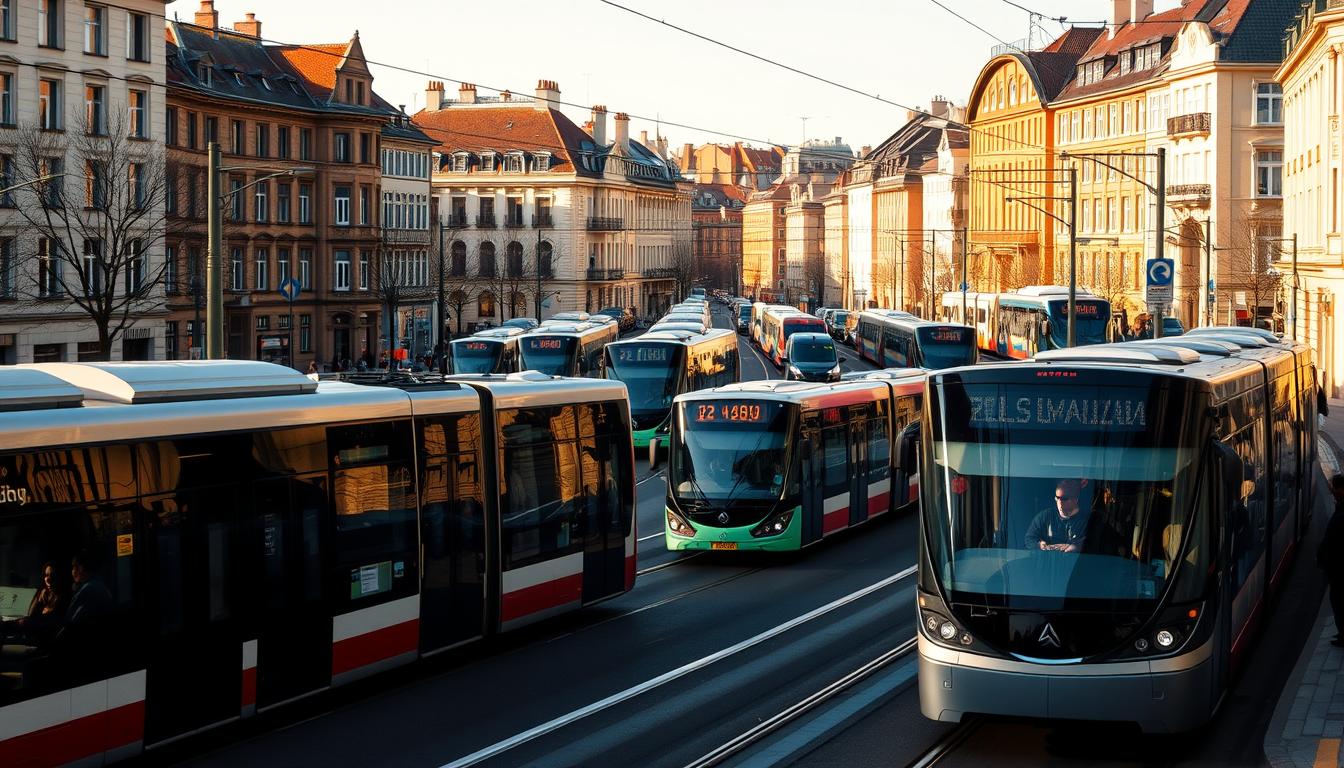Navigating Germany’s efficient public transport system is crucial for a seamless travel experience. With an extensive network of buses, trams, underground trains, and rapid transit systems, getting around without a car is convenient. Düsseldorf Consulting GmbH, located at Königsallee 22, 40212 Düsseldorf, emphasizes the importance of understanding these systems.
Germany’s public transport is well-organized, with clear timetables and routes, making it easy to explore major cities like Berlin and Munich. For more information on mobility options in Germany, including the “Deutschland-Ticket” and its benefits, you can refer to the Handbook Germany.
Key Takeaways
- Germany has a comprehensive public transport network.
- The “Deutschland-Ticket” offers affordable monthly travel.
- Discounts are available for certain groups, such as students and trainees.
- The ticket can be cancelled monthly.
- Children under 6 travel for free with the “Deutschland-Ticket.”
Overview of Transportation Systems in Germany
Germany boasts a sophisticated transportation infrastructure that caters to various needs, making it a model for efficient urban mobility. The country’s transportation system is diverse, encompassing a wide range of options including buses, underground trains, S-Bahn trains, and trams.
Public transport is the backbone of urban mobility in Germany, providing an affordable and environmentally friendly way to navigate cities. The ticketing systems vary across cities, with options to buy tickets at machines, from drivers, or via apps, making it convenient for commuters.
“A well-developed transportation system is crucial for the economic and social development of a country.”
The variability in ticketing systems across different cities in Germany can be seen in the following table:
| City | Ticketing Options | Primary Mode of Transport |
|---|---|---|
| Berlin | Ticket machines, Apps | U-Bahn, S-Bahn |
| Munich | Ticket machines, Drivers | U-Bahn, Trams |
| Hamburg | Apps, Drivers | S-Bahn, Buses |
The importance of public transport in Germany cannot be overstated, as it not only provides a convenient mode of transportation but also contributes to reducing the carbon footprint. As stated, “ACTA NON VERBA,” the actions speak louder than words, and Germany’s transportation system is a testament to this, with its reliability and extensive coverage.
In conclusion, Germany’s transportation infrastructure is a well-oiled machine, with public transport being a critical component. Understanding the various ticketing systems and options available is key to navigating the country’s urban mobility landscape efficiently.
The Role of Public Transportation
In Germany, public transportation plays a crucial role in facilitating daily commutes and long-distance travel. It is the backbone of the country’s transportation infrastructure, ensuring that both urban and rural areas are well-connected.
Public transport is more frequent in urban areas, where comprehensive networks of buses, trams, and trains are available. Deutsche Bahn, Germany’s national railway company, is a key provider of train services, offering efficient and reliable connections across the country. In addition to Deutsche Bahn, local transport companies operate bus and tram services, catering to the daily commuting needs of the population.
In contrast, rural areas have less frequent public transport services. Often, bus connections are the primary means of public transportation in these regions. Despite the lower frequency, public transportation remains vital for rural communities, providing them with access to urban centers and essential services.
The efficiency of Germany’s public transportation system can be attributed to the coordinated efforts of various service providers. Deutsche Bahn and local transport companies work together to ensure a seamless travel experience. This integrated approach to public transportation is a hallmark of Germany’s transportation solutions, making it one of the most reliable in the world.
In conclusion, public transportation is indispensable to Germany’s transportation network. Its comprehensive coverage and reliability make it an attractive option for both daily commutes and long-distance travel, supporting the country’s economic and social activities.
Germany’s Rail Network
Germany boasts an extensive and efficient rail network, with Deutsche Bahn operating high-speed trains that link major cities like Berlin, Munich, and Frankfurt. This comprehensive network is a cornerstone of public transportation in Germany, facilitating smooth and relatively quick travel across the country.
The high-speed trains, such as Intercity Express (ICE) and Intercity (IC), are particularly popular for their speed and comfort. The ICE, for instance, can reach speeds of up to 320 km/h, making it an ideal choice for both business travelers and tourists. As a result, mobility trends in Germany show a preference for rail travel due to its convenience and relatively low environmental impact.

The efficiency of Germany’s rail network is further enhanced by its well-organized schedule and frequent departures. Passengers can enjoy the convenience of traveling without the hassle of traffic jams or parking issues associated with road travel. Moreover, the rail network’s connectivity to major airports and city centers makes it an integral part of Germany’s transportation infrastructure.
Some of the key benefits of Germany’s rail network include:
- High-speed travel between major cities
- Frequent departures and well-organized schedules
- Comfortable and convenient travel options
- Relatively low environmental impact compared to other modes of transportation
As noted by a transportation expert, “The rail network is the backbone of Germany’s transportation system, providing a reliable and efficient way to travel across the country.” This sentiment is echoed by the popularity of rail travel among both locals and tourists, highlighting the significance of Germany’s rail network in its overall transportation landscape.
Road Transportation in Germany
Germany’s road transportation network is renowned for its efficiency and connectivity, with the Autobahn being a standout feature. The Autobahn is famous for its sections without speed limits, though many sections do have limits to ensure safety. Major highways connect cities and regions, facilitating road travel and supporting both urban mobility and long-distance journeys.
At the heart of Germany’s road transportation is the Autobahn, a symbol of the country’s engineering capabilities. While some sections have no speed limits, others are restricted to ensure safety, especially in urban areas or during adverse weather conditions. This mix of unrestricted and limited sections allows for a flexible and efficient travel experience.
Sustainable transportation initiatives are increasingly being integrated into Germany’s road travel infrastructure. Efforts to reduce emissions and promote eco-friendly vehicles are underway, supporting the country’s commitment to environmental sustainability. Urban mobility is also being enhanced through the development of efficient public transportation systems and infrastructure that supports cycling and walking.
To illustrate the complexity and efficiency of Germany’s road network, consider the following table that highlights key statistics related to road transportation in Germany:
| Category | Description | Statistic |
|---|---|---|
| Autobahn Length | Total length of Autobahn network | Approximately 13,000 km |
| Highway Connectivity | Major cities connected by highways | Over 200 cities |
| Sustainable Vehicles | Number of eco-friendly vehicles on the road | Growing annually by 15% |
As Germany continues to evolve its transportation infrastructure, the focus on sustainable transportation and urban mobility remains a priority. The integration of eco-friendly vehicles and the expansion of public transportation options are expected to play a crucial role in shaping the future of road travel in Germany.
For instance, cities like Düsseldorf, with its well-planned infrastructure, including the famous Königsallee at 40212 Düsseldorf, serve as models for urban mobility. Such areas demonstrate how effective planning can enhance the travel experience while promoting sustainability.
Sustainable Mobility Initiatives
Sustainable mobility initiatives are gaining momentum in Germany, driven by government incentives and infrastructure development. This shift is part of a broader strategy to reduce carbon emissions and improve air quality, reflecting a significant change in Germany’s transportation infrastructure.
Germany is promoting e-mobility through various measures, including the development of charging infrastructure for electric vehicles. Companies like Düsseldorf Consulting GmbH are playing a crucial role in this transition by providing consulting services that support the adoption of electric vehicles.
ACTA NON VERBA ! (Deeds, not words!) This mantra is particularly relevant in the context of Germany’s sustainable mobility initiatives, where tangible actions are being taken to reduce environmental impact.
The development of charging infrastructure is a critical component of Germany’s e-mobility strategy. The following table illustrates the growth in the number of charging points across different regions in Germany.
| Region | 2020 | 2022 | 2024 (Projected) |
|---|---|---|---|
| North Rhine-Westphalia | 1,500 | 3,000 | 5,000 |
| Bavaria | 1,000 | 2,500 | 4,000 |
| Baden-Württemberg | 800 | 2,000 | 3,500 |
- Expansion of charging infrastructure for electric vehicles
- Incentives for adopting e-mobility solutions
- Investment in sustainable public transportation
These initiatives underscore Germany’s commitment to creating a more sustainable transportation system. As the country continues to invest in e-mobility and other eco-friendly transportation options, it is likely to serve as a model for other nations.
Biking and Walking Infrastructure
With a strong focus on environmental sustainability, German cities are developing extensive biking and walking infrastructure. Many German cities are designated as bicycle-friendly, with dedicated bike lanes and rental services that encourage cycling as a viable mode of transport.
The city’s infrastructure not only promotes a healthier lifestyle but also contributes to reduced traffic congestion and environmental sustainability, aligning with mobility trends in Germany that favor more eco-friendly options. For instance, cities like Düsseldorf have made significant strides in this area, with places like Königsallee 22, 40212 Düsseldorf, showcasing well-designed pedestrian and cycling paths.

These transportation solutions are part of a broader strategy to make urban mobility more sustainable. By investing in biking and walking infrastructure, Germany is setting a precedent for other countries to follow in terms of reducing reliance on fossil fuels and promoting greener modes of transport.
The benefits of such infrastructure are multifaceted, including reduced air pollution, enhanced road safety, and increased physical activity among the population. As Germany continues to evolve its transportation systems, the role of biking and walking infrastructure is likely to become even more prominent.
The Future of Transportation in Germany
As Germany looks to the future, its transportation sector is poised for significant changes, driven by the need for sustainable and efficient mobility solutions. Innovations in mobility technology, including ride-hailing services and smart traffic management systems, are transforming the way people move around the country.
The government’s commitment to sustainable transportation is evident in its policies aimed at reducing emissions and promoting eco-friendly vehicles. This shift is not only beneficial for the environment but also enhances the efficiency of public transportation systems, making them more appealing to commuters.
One of the key areas of focus is the integration of ride-hailing services into the existing public transportation network. By doing so, Germany aims to create a seamless travel experience that combines the benefits of different modes of transport. For more information on Germany’s approach to mobility and sustainability, visit https://www.tatsachen-ueber-deutschland.de/en/sustainability-and-environment/mobility-future.
Key Initiatives in Sustainable Mobility
- Promotion of electric and hybrid vehicles
- Investment in smart traffic management systems
- Integration of ride-hailing services with public transport
- Expansion of cycling and pedestrian infrastructure
The impact of these initiatives can be seen in the growing adoption of sustainable transportation methods among the German populace. As the country continues to innovate and invest in its transportation infrastructure, the future looks promising for both the environment and the mobility needs of its citizens.
| Initiative | Description | Impact |
|---|---|---|
| Electric Vehicle Promotion | Incentives for adopting electric vehicles | Reduction in emissions |
| Smart Traffic Management | Real-time traffic monitoring and optimization | Reduced congestion |
| Ride-hailing Integration | Combining ride-hailing with public transport | Enhanced mobility |
The future of transportation in Germany is not just about adopting new technologies but also about creating a sustainable transportation ecosystem that benefits everyone. With continued investment and innovation, Germany is set to become a leader in mobility solutions.
Challenges Facing Transportation in Germany
Despite advancements, Germany’s transportation system grapples with congestion and accessibility concerns, particularly in urban areas. The efficiency of Germany’s transportation network is well-regarded, but it faces significant challenges that need to be addressed to maintain its high standards.
One of the primary challenges is traffic congestion in urban centers. Cities like Berlin, Munich, and Hamburg experience heavy traffic, leading to increased travel times and decreased air quality. Efforts to mitigate this include improving public transportation systems and promoting alternative modes of transport.
Improving urban mobility is a key focus area. This involves not only enhancing public transportation but also developing infrastructure that supports cycling and walking. By creating more pedestrian-friendly and cyclist-friendly environments, cities can reduce reliance on personal vehicles and decrease congestion.
The condition and capacity of transportation infrastructure are also critical concerns. Aging infrastructure requires maintenance and upgrading to support the current demands of the transportation network. This includes not just roads but also rail networks and public transportation systems.
Key Challenges and Potential Solutions
| Challenge | Potential Solution |
|---|---|
| Traffic Congestion | Improve Public Transportation, Promote Cycling and Walking |
| Aging Infrastructure | Regular Maintenance and Upgrades |
| Accessibility Concerns | Enhance Public Transport Accessibility, Improve Pedestrian Infrastructure |
Düsseldorf Consulting GmbH and other organizations are working to address these challenges through innovative solutions and strategic planning. By focusing on sustainable mobility initiatives and improving transportation infrastructure, Germany can continue to have an efficient and effective transportation system.
Ultimately, the future of transportation in Germany depends on successfully navigating these challenges. By prioritizing urban mobility, maintaining and upgrading transportation infrastructure, and promoting sustainable practices, Germany can ensure that its transportation system remains a model for other countries.
Tips for Navigating Transportation in Germany
Navigating Germany’s transportation network can be a seamless experience with the right knowledge and tools. Understanding the ticketing systems is crucial, as they vary across cities. Many cities, such as Düsseldorf, offer convenient options like mobile apps for purchasing tickets, making travel more efficient.
To make the most of German transportation systems, it’s essential to familiarize yourself with transportation solutions like the Deutsche Bahn app, which provides real-time information and ticket purchasing capabilities. Staying informed about mobility trends in Germany can also help you plan your route and avoid disruptions.
By leveraging these resources and understanding the ticketing systems, you can enjoy a hassle-free travel experience in Germany. Whether you’re exploring the Königsallee in Düsseldorf or traveling across the country, being prepared will make all the difference.



